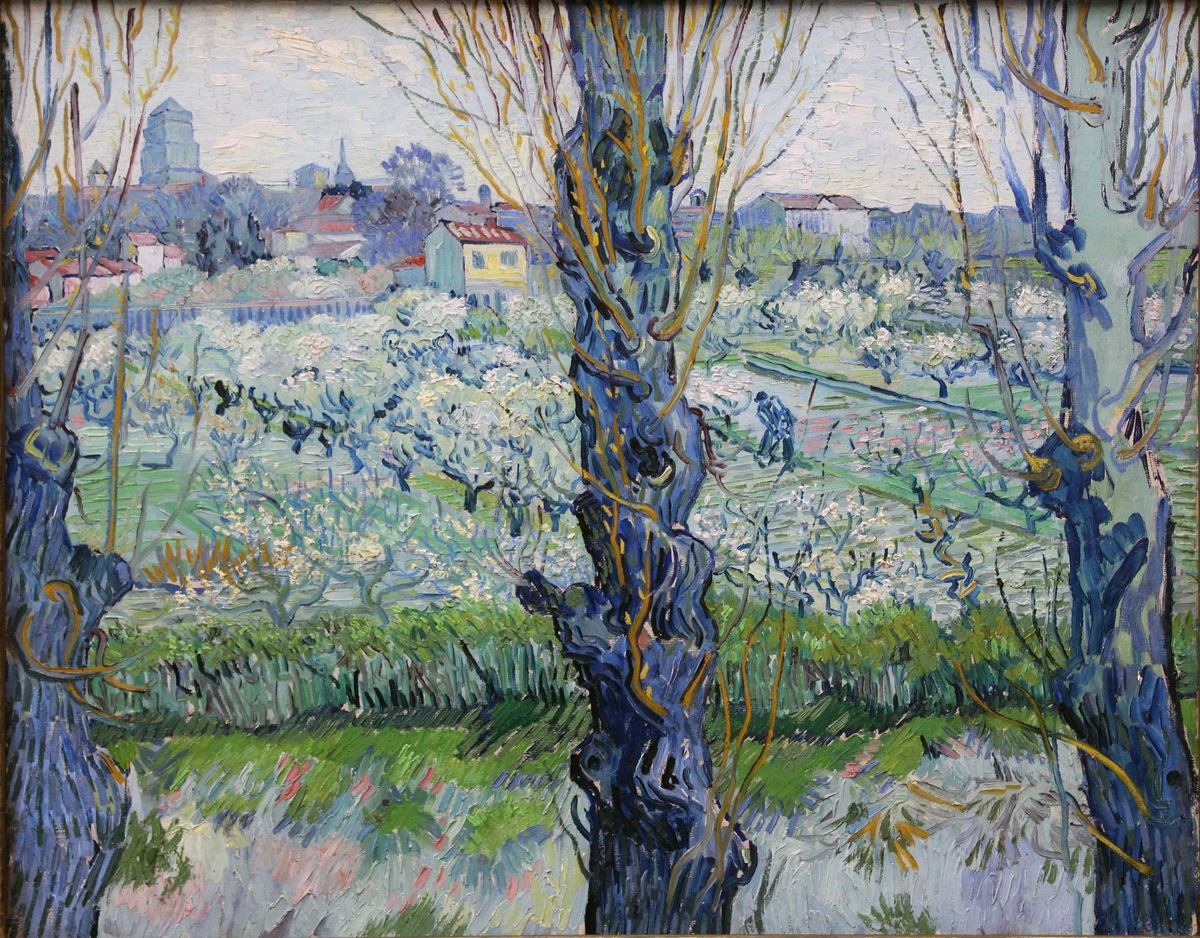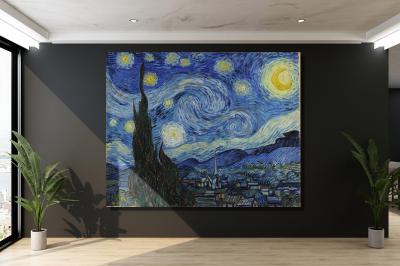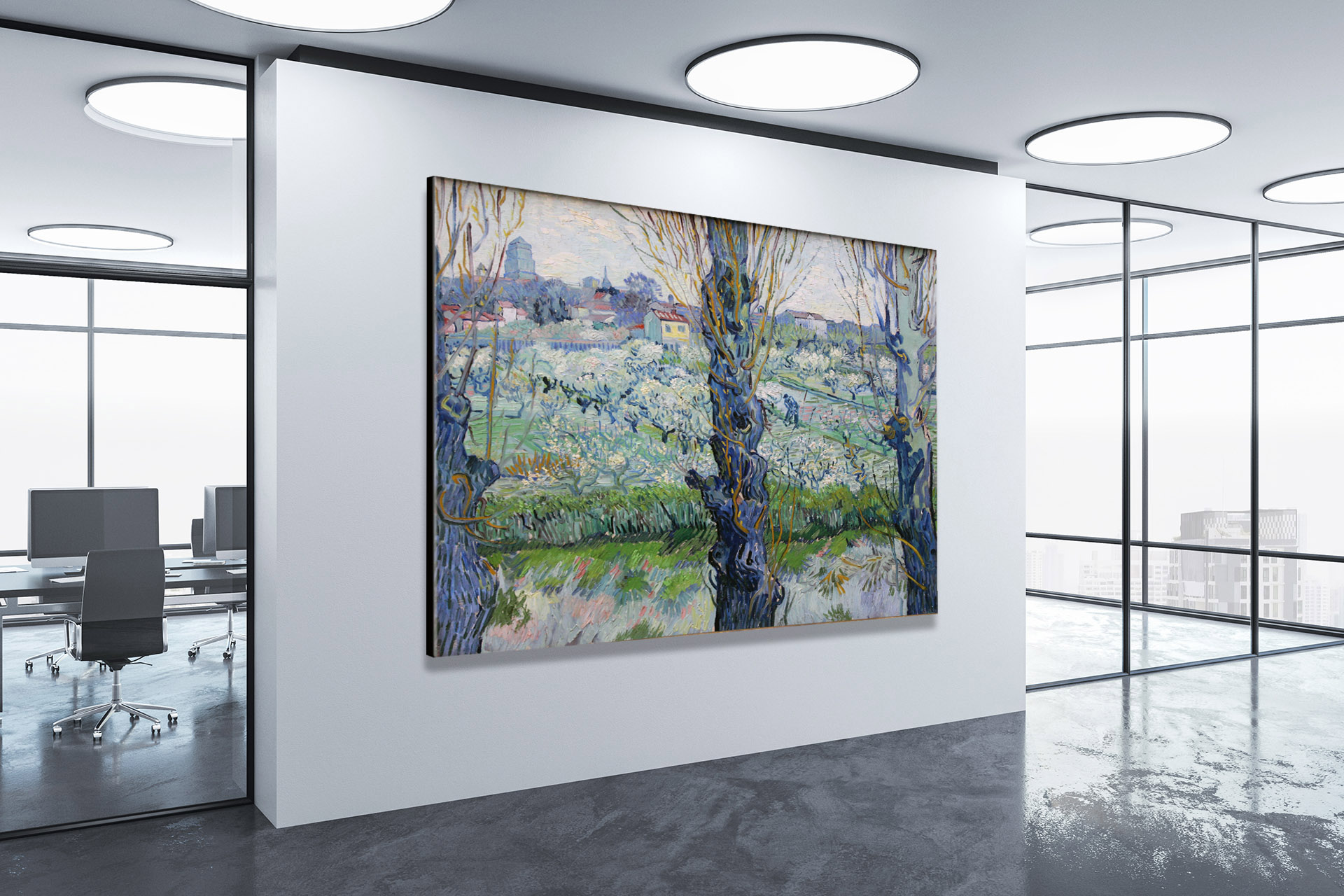View of Arles
By Vincent van Gogh, 1889
View of Arles: Vincent van Gogh’s Luminous Ode to the South
Vincent van Gogh, a name synonymous with passion, creativity, and emotional depth, left an indelible mark on the world of art. Among the plethora of masterpieces that emerged from his short but prolific career, “View of Arles” stands as a radiant and captivating testament to the beauty and vitality of the South of France. This masterpiece not only captures the essence of Arles but also provides a profound glimpse into the artist’s turbulent inner world, while also presenting unique technical challenges in its creation.
Van Gogh’s Fascination with Arles
Vincent van Gogh’s deep connection with Arles can be traced back to his yearning for respite from the chaos of urban life. In February 1888, Van Gogh embarked on a transformative journey to Arles, a picturesque town nestled in the heart of Provence, where he intended to find solace and artistic inspiration.
Over the course of his stay in Arles, which spanned approximately a year, Van Gogh produced a plethora of works that would become iconic in the world of art. Yet, “View of Arles” is a masterpiece that remains etched in the annals of art history as a profound representation of the region that so deeply moved him.
“View of Arles” Large Canvas Prints from WhiteClouds
A Glimpse into Van Gogh’s Vision
“View of Arles” is a canvas of sheer brilliance that encapsulates Van Gogh’s artistic vision. At first glance, the painting is a sweeping panorama of the town’s outskirts, overlooking the tranquil Rhône River. The hallmark of Van Gogh’s work, his dynamic and emotionally charged use of color, takes center stage in this composition. Swirling strokes of vibrant yellow, lush green, and calming blue create a visual symphony that resonates with viewers on a deep, emotional level.
What sets “View of Arles” apart is Van Gogh’s masterful impasto technique, characterized by thickly layered brushstrokes. This technique not only adds texture and depth to the painting but also invites viewers to engage with the scene on a sensory level. One can almost feel the warmth of the sun on their skin and hear the rustling of the wheat fields in the gentle breeze, making the painting an immersive experience.
Technical Challenges and Unique Perspective
Creating “View of Arles” presented Van Gogh with a series of technical challenges. The elevated vantage point from which he chose to depict the landscape required meticulous attention to detail. Van Gogh had to painstakingly capture the intricate contours of the town, the curvature of the river, and the interplay of light and shadow on the fields. This level of precision demanded both skill and patience, as well as an acute awareness of the changing light and weather conditions of the South of France.
The Colors of Emotion
Van Gogh’s use of color in “View of Arles” is a testament to his innate ability to convey emotion through art. The fiery and exuberant sunflowers, the vivacious green of the fields, and the serene blue of the river all harmonize to evoke a complex emotional landscape. These colors, while celebrating the beauty of the region, also hint at the tumultuous emotions that swirled within the artist’s soul.
Van Gogh’s Battle with Mental Health
Van Gogh’s life was marked by a perpetual struggle with mental health issues, and his time in Arles was no exception. It was during this period that he infamously severed his own earlobe in an act of profound despair. The stark contrast between the vibrancy of his surroundings and the turbulence of his inner world is a poignant reminder of the intricate interplay between an artist’s emotional turmoil and their creative output.
Legacy and Impact
“View of Arles” is not just a landscape painting; it is a window into the depths of Van Gogh’s soul. The painting’s enduring legacy is a testament to the power of art to transcend time and space. Van Gogh’s unique style and emotional intensity continue to captivate audiences worldwide, and “View of Arles” remains a radiant representation of his artistic brilliance.
The Painter: Vincent van Gogh
Vincent van Gogh, born in 1853 in the Netherlands, was a troubled but immensely talented artist whose life and work have left an indelible mark on the art world. Despite his tumultuous inner battles, Van Gogh’s commitment to his craft never wavered. He was a prolific artist, creating over 2,000 works of art during his short 37 years of life.
Van Gogh’s art was characterized by bold colors, dynamic brushwork, and a deep emotional resonance. His unique style, often described as post-impressionist, broke away from the traditional artistic norms of his time and laid the foundation for future art movements such as expressionism.
Throughout his life, Van Gogh struggled with mental health issues, including depression and episodes of psychosis. Despite his challenges, he found solace and purpose in painting, using art as a means of self-expression and catharsis. His letters to his brother Theo provide invaluable insights into his thoughts, struggles, and creative process.
Tragically, Van Gogh’s life was cut short when he died by suicide in 1890. His work, however, endured and gained recognition and appreciation in the years following his death. Today, Vincent van Gogh is celebrated as one of the most influential and iconic artists in history, with his paintings, including “View of Arles,” gracing the walls of museums and galleries worldwide, continuing to inspire and move generations of art enthusiasts. His tumultuous life and extraordinary talent have left an enduring legacy that transcends time and place.
 View of Arles by Vincent van Gogh
View of Arles by Vincent van Gogh
Conclusion
In “View of Arles,” Vincent van Gogh’s artistic genius finds its fullest expression. This masterpiece, with its vibrant colors, dynamic brushwork, and unique perspective, allows us to experience the beauty and intensity of the South of France through the eyes of a tormented but extraordinarily gifted artist. It stands as a timeless confirmation to the enduring power of art to convey the depths of human emotion and the beauty of the world around us, reminding us of Van Gogh’s indelible mark on the art world and his ability to touch the hearts of generations to come.
Frequently Asked Questions About “View of Arles”
What is the significance of “View of Arles” in Vincent van Gogh’s body of work? “View of Arles” holds great significance in Van Gogh’s body of work as it reflects his artistic evolution during his time in Arles. It captures the essence of the South of France, a region that deeply inspired him, and exemplifies his bold use of color, unique perspective, and emotional depth.
Where is “View of Arles” currently housed or displayed? The current location of “View of Arles” may vary over time due to loans to exhibitions and changes in ownership. As of my knowledge cutoff date in January 2022, it may have been housed in a museum or private collection.
Can you provide some background information about the location depicted in the painting? The location depicted in the painting is Arles, a picturesque town in the South of France. Arles was a source of inspiration for Van Gogh, and he produced many of his iconic works during his stay there in the late 19th century.
What inspired Vincent van Gogh to paint “View of Arles”? Van Gogh was inspired to paint “View of Arles” by the serene beauty of the southern French landscape. The vibrant colors, rolling hills, and picturesque scenery of Arles captured his imagination and motivated him to capture the essence of the region on canvas.
What is the story behind the creation of “View of Arles”? The creation of “View of Arles” is a testament to Van Gogh’s deep connection with the region. During his stay in Arles, he produced numerous paintings inspired by the local landscape, and this particular work was born out of his desire to convey the beauty and vitality of the South of France.
What is the meaning or symbolism behind the colors used in the painting? The colors in “View of Arles” are not just representations of the scene but also convey Van Gogh’s emotions. The vibrant colors, such as yellow and green, symbolize optimism and vitality, while the blue of the river represents serenity. The juxtaposition of these colors hints at the complex interplay of emotions in Van Gogh’s life.
How did Van Gogh’s mental state at the time of creating “View of Arles” influence the artwork? Van Gogh’s mental health struggles during his time in Arles were tumultuous, and they undoubtedly had an impact on his artwork. The contrast between the vibrant scene and his inner turmoil is evident in the painting, adding depth and complexity to the work.
What technical challenges did Van Gogh face while working on this painting? Creating “View of Arles” presented technical challenges due to the elevated perspective and the need to capture intricate details of the landscape. Van Gogh had to meticulously render the contours of the town and master the interplay of light and shadow, demanding skill and patience.
Are there any hidden details or messages within “View of Arles” that art experts have discovered? While there are no known hidden details or messages within “View of Arles,” art experts have extensively studied the painting for insights into Van Gogh’s technique and emotional expression. The impasto technique and brushwork reveal his artistic process and emotional intensity.
How has “View of Arles” influenced other artists or art movements? “View of Arles” and Van Gogh’s distinctive style have left an indelible mark on art history. His bold use of color and expressive brushwork influenced future art movements such as expressionism and played a significant role in shaping modern art.
Can you provide information about the historical context of Arles during the time Van Gogh painted this scene? Arles was a quaint town in the South of France known for its picturesque landscapes and historical significance. Van Gogh’s stay in Arles coincided with a period of cultural and artistic renaissance in the region, making it a vibrant and inspiring place for the artist.
What is the current estimated value of “View of Arles” in today’s art market? The estimated value of “View of Arles” can vary significantly depending on factors such as the specific painting’s provenance, condition, and demand in the art market. Prices for Van Gogh’s works have reached astronomical figures in recent years, with some paintings selling for hundreds of millions of dollars.
How does “View of Arles” compare to other famous works by Vincent van Gogh in terms of style and subject matter? “View of Arles” shares stylistic elements with other famous works by Van Gogh, such as “Starry Night” and “Sunflowers.” However, its unique subject matter and perspective set it apart, showcasing the artist’s versatility and ability to capture diverse scenes and emotions.
Are there any controversies or debates surrounding the authenticity or provenance of “View of Arles”? As of my knowledge cutoff date in January 2022, there were no widely known controversies or debates regarding the authenticity or provenance of “View of Arles.” However, provenance research in the art world is ongoing, and new information may have emerged since that time.
What techniques and materials did Van Gogh employ to create “View of Arles,” and how have they contributed to the painting’s unique texture and appearance? Van Gogh used oil paints and an impasto technique characterized by thickly layered brushstrokes to create “View of Arles.” This technique adds texture and depth to the painting, giving it a tactile quality that allows viewers to feel the scene’s vibrancy and intensity.
Can you explain the significance of the elevated perspective Van Gogh chose for this particular scene? Van Gogh’s choice of an elevated perspective in “View of Arles” offers viewers a panoramic view of the landscape, allowing them to take in the breathtaking scenery of Arles. This perspective showcases his mastery of capturing the grandeur and beauty of the region.
How has the public’s perception of “View of Arles” changed over time, from its creation to the present day? “View of Arles” has evolved from being a relatively unknown painting during Van Gogh’s lifetime to becoming an iconic representation of his artistic genius. Over time, it has garnered recognition and appreciation, with audiences worldwide valuing its emotional depth and unique beauty.
Are there any notable exhibitions or events where “View of Arles” has been prominently featured? “View of Arles” may have been featured in various exhibitions and events dedicated to Van Gogh’s work or post-impressionist art. Prominent museums and galleries often include this masterpiece in exhibitions celebrating the artist’s legacy.
Other Articles on Vincent van Gogh Paintings
At Eternities Gate by Vincent Van Gogh, 1890
Blossoming Almond Tree by Vincent Van Gogh, 1890
Cafe Terrace at Night by Vincent Van Gogh, 1888
Daubigneys Garden by Vincent Van Gogh, 1890
Green Wheat Field with Cypress by Vincent Van Gogh, 1889
Houses at Auvers by Vincent Van Gogh, 1890
Irises by Vincent Van Gogh, 1889
Night Café by Vincent Van Gogh, 1888
Portrait of Dr. Gachet by Vincent Van Gogh, 1890
Red Vineyards by Vincent Van Gogh, 1888
Road with Cypress and Star by Vincent Van Gogh, 1890
Starry Night by Vincent Van Gogh, 1889
Starry Night over the Rhone by Vincent Van Gogh, 1888
Sunflowers by Vincent Van Gogh, 1887
The Bedroom by Vincent Van Gogh, 1888
The Church at Aurers by Vincent Van Gogh, 1890
The Garden of the Asylum by Vincent Van Gogh, 1889
The Mulberry Tree by Vincent Van Gogh, 1889
The Potato Eaters by Vincent Van Gogh, 1885
The Yellow House by Vincent Van Gogh, 1888
Tree Roots by Vincent Van Gogh, 1890
Van Gogh Self Portrait by Vincent Van Gogh, 1887
Vase with Red Poppies by Vincent Van Gogh, 1886
View of Arles by Vincent Van Gogh, 1889
Wheat Field with Crows by Vincent Van Gogh, 1890
Wheat Field with Cypresses by Vincent Van Gogh, 1889
More WhiteClouds Videos
Contact us today to learn more about our 3D services and how we can help you achieve your goals.

